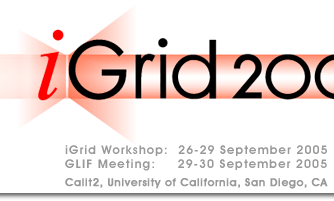News Releases
Science, Art, Advanced Networks Meet at iGrid 2005
By Katie Yurkewicz
Science Grid This Week, October 5, 2005 - Advanced optical networks and light path technology were on display at iGrid 2005, held September 26-30 at the new Calit2 building on the campus of the University of California, San Diego. The workshop showcased more than four dozen demonstrations of applications using high-speed optical networks, and also included a symposium with lectures, panel discussions and master classes on applications, middleware and underlying cyberinfrastructure for 10 gigabit optical networks.
“We only organize an iGrid when there’s a new level of technology available,” said Tom DeFanti, iGrid 2005 co-chair. “This workshop was organized because of the global availability of light paths. The goal of iGrid 2005 was to build a team that knows and trusts each other, and that knows how to control and request light paths for applications and users.”
Light paths are direct connections between the source of data and the recipient over an optical network. While the technology has been available for several years, only recently has the technology advanced - although still in an experimental stage - to support on-demand requests by application users.
A 9,000 mile light path from Keio University in Japan to the Calit2 building in San Diego enabled one of the first demonstrations of the workshop, the world’s highest-resolution videoconference using 4K digital video. The president of Keio University and Chancellor of UCSD took part in the videoconference, which was shown on a theater screen with four times the resolution of high-definition television. Along with the videoconference, 4K real-time streaming was used to display digital motion pictures, still camera images and computer animations from Keio University in the auditorium in San Diego.
“Monday night was the culmination of ten years of work for me and others,” said DeFanti. “I got involved in optical networking because I knew we wouldn’t be able to do that kind of real-time projection with conventional router-based network technology.”
To support all the demonstrations, 100 gigabits of optical network bandwidth were brought in to the newly-finished building in just over a week. Organizers dealt with problems large and smallincluding building 50 extension cords by hand two nights before the workshop openingbut by Monday night, hundreds of attendees lined up to view applications from the physical sciences to the visual arts using the available 10 gigabit network links. Collaborative visualization and simulation, high-speed worldwide data transfer, 3D and high-definition real-time videoconferencing and advanced on-demand network security were among the demonstrations offered at iGrid 2005.
Related Links: www.interactions.org/sgtw/2005/1005/igrid2005_more.html


